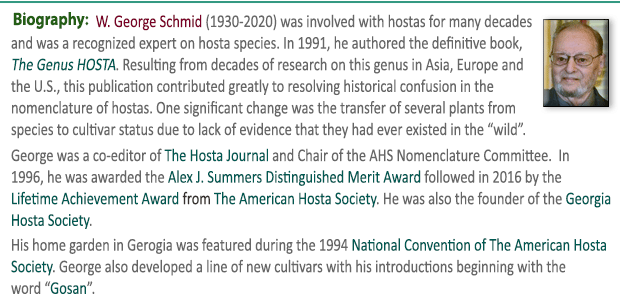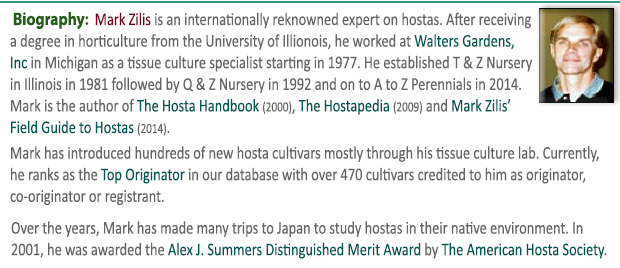|
 Native
to
Korea, this fast growing, dark green hosta has rippled, shiny, heart-shaped leaves with a
piecrust margin. It forms a flat, medium size mound about 16 inches high
by 38 inches wide. Purple flowers in clusters with yellowish anthers
from late June into July.
It sets viable seeds. Native
to
Korea, this fast growing, dark green hosta has rippled, shiny, heart-shaped leaves with a
piecrust margin. It forms a flat, medium size mound about 16 inches high
by 38 inches wide. Purple flowers in clusters with yellowish anthers
from late June into July.
It sets viable seeds.
 According to
The Genus Hosta by W. George Schmid (1991), this species was first collected from the wild in
1916. He states that the plant's "...large globular flower bud is
dark violet just before opening, leading to its epithet, which
is derived from capitatus = with a knoblike head or tip. According to
The Genus Hosta by W. George Schmid (1991), this species was first collected from the wild in
1916. He states that the plant's "...large globular flower bud is
dark violet just before opening, leading to its epithet, which
is derived from capitatus = with a knoblike head or tip.
According to
The Hostapedia by
Mark Zilis (2009), "...can easily be identified by
its rippled, green leaves and unusual clusters of purple
flowers..."
 From the
Field Guide to Hostas by Mark Zilis (2014), "...will never be at the top of popularity polls, but it
makes an attractive specimen in the garden and can be a valuable
breeding plant. Its rippled leaf margin and large purple flowers
that cluster at the top of the scapes are desirable genetic
traits." From the
Field Guide to Hostas by Mark Zilis (2014), "...will never be at the top of popularity polls, but it
makes an attractive specimen in the garden and can be a valuable
breeding plant. Its rippled leaf margin and large purple flowers
that cluster at the top of the scapes are desirable genetic
traits."
The New Encyclopedia of Hostas by
Diana
Grenfell (2009) states: "Useful as a breeding plant for producing piecrust
leaf edges and heavy racemes of purple flowers that cluster
around the scape...Scapes are noticeably ridged. Flower buds are
tightly ball-shaped."
Mark Zilis' Field Guide to Hostas (2014)
states that this species was found in Japan in "...woodlands; in
rocks along a river..."

 An article about favorite flowering hostas by W. George Schmid in
The
Hosta Journal (2006 Vol. 37 No. 2) says, "The best
flowers are on H. plantaginea and its multi-petalous cousins, 'Venus'
and
'Aphrodite'...H. capitata in bud is fine, but its offspring, 'Nakaimo' has
flowers that begin with the shine of precious porcelain and stay closed in bud
longer...H. kikutii forms all have fine and late flowers, but the best are on
H. kikutii var. densa (H. densa). They are white and form a tight bunch at the top
of the scape. H. laevigata has large, spidery flowers in abundance; its cousin
H. yingeri has smaller ones with the same spidery character and dark color.
These spidery flowers are carried all around the stem unlike other hosta flowers
that, "lean to one side...Finally, mature clumps of 'Blue Angel' and 'Elegans'
have a beautiful flower display when many flowers on different scapes open in
unison..." An article about favorite flowering hostas by W. George Schmid in
The
Hosta Journal (2006 Vol. 37 No. 2) says, "The best
flowers are on H. plantaginea and its multi-petalous cousins, 'Venus'
and
'Aphrodite'...H. capitata in bud is fine, but its offspring, 'Nakaimo' has
flowers that begin with the shine of precious porcelain and stay closed in bud
longer...H. kikutii forms all have fine and late flowers, but the best are on
H. kikutii var. densa (H. densa). They are white and form a tight bunch at the top
of the scape. H. laevigata has large, spidery flowers in abundance; its cousin
H. yingeri has smaller ones with the same spidery character and dark color.
These spidery flowers are carried all around the stem unlike other hosta flowers
that, "lean to one side...Finally, mature clumps of 'Blue Angel' and 'Elegans'
have a beautiful flower display when many flowers on different scapes open in
unison..."



|



